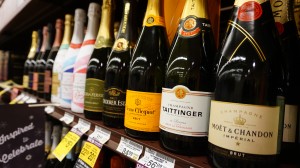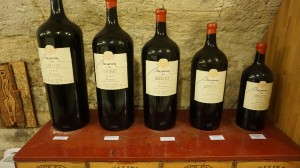All that sparkles is a treasure trove of trivia


True Champagne and Champagne-style wines can be conveniently purchased at grocery stores such as this well-stocked Safeway shelf. Viki Eierdam
‘Tis the weekend for bubbles; the effervescent that embodies celebration. As more than one third of you shop the grocery store aisles for your New Year’s toast of choice, keep in mind that you live in one of 35 U.S. states allowed to sell wine in grocery stores.
And so goes this column—one sprinkled with trivia worthy of idle banter at a New Year’s party.
Many of us know that true Champagne can only come from the designated region of Champagne, located 90 miles northeast of Paris. Names like Champagne-style, sparkling and bubbles connote the fantastical beverage made outside this strictly-regulated area.
Chardonnay, pinot noir and pinot meunier are the three grapes found in traditional Champagne. Macabeo, Parellada, and Xarel-lo make up Spanish Cava.
Other bottle-fermented sparkling wines include Crémant—most famously made in the Loire Valley—and Cava from Spain. Prosecco is Italy’s version of sparkling although it is traditionally tank-fermented resulting in a fruitier style wine.
The Champagne region is made up of seventeen villages ranked Grand Cru, 44 ranked Premier Cru and then there are Grower Champagnes—still quality Champagne houses within the Champagne region that don’t fall under Grand Cru or Premier Cru status—where excellent values can be had.

Regional Champagne-style wines such as Oregon’s Argyle are a treasure among other bottle-fermented sparklings from Spain, Australia and France. Viki Eierdam
Regional Champagne-style wines such as Oregon’s Argyle are a treasure among other bottle-fermented sparklings from Spain, Australia and France found at local Fred Meyer stores. Viki Eierdam
Interesting tidbits only begin there. Pick up a bottle of bubbles and you’re sure to notice immediately that there’s something different about it. The bottle is intentionally stout to keep the wine from exploding. In fact, experts cite that the pressure in a champagne bottle is equivalent to two to three times the pressure in a car tire—stemming from the double fermentation process that creates the sought-after bubbles.
At the base of the bottle is an indent called a punt. Although it now has other uses, it was originally conceived to add strength to the glass.
Just like the present that it is, the top of sparkling wine is wrapped in foil. Unwrapping only heightens the anticipation. Revealed underneath is a wire cage called a muselet. If not for this contraption, the cork could blow at any moment. To open the bottle, the ring on the muselet must be bent to a horizontal position and turned, counter-clockwise. Research proves that every muselet requires six half turns of the ring to be removed. That’s my kind of research.
Once the muselet is no longer corralling the cork, keep a firm grip on it or it’s liable to shoot off prematurely. I’ve seen it happen at industry events so all levels of expertise are prone to this faux pas.
You’ll notice that even the rim at the opening of a champagne bottle is different. Called an annulus, its protruding shape secures the muselet to the bottle.

Large format bottles—often containing bubbles—are named after Biblical characters; more specifically, kings in the Old Testament. There’s the Jeroboam which holds 4 regular bottles; Rehoboam holds 6; Methuselah contains 8; Salmanazar equals 12; Balthazar filled with 16; and Nebuchadneezer at a whopping 20. In Bordeaux, the names are slightly different and include a Melchior at a party-invoking 24 bottles. Viki Eierdam
Then there’s the cork. Denser than still wine corks, again to contain contents under pressure, its shape is initially similar to a normal cork and becomes mushroom-shaped after compression and expansion.
We’ve all seen—in person or otherwise—the dramatic uncorking of a Champagne bottle. There’s this impressive pop, the cork shoots out on a haphazard trajectory and bubbles spit and pour everywhere.
May I suggest a less flamboyant idea; opening the bottle to avoid an insurance claim. Once the wire cage is removed, always hold the cork. You’ll gain better leverage by twisting the bottle from the base rather than twisting the cork. Once popped, pour the wine with the bottle at an angle into a fluted glass that is also held at an angle. This will reduce the foaming and keep the beautiful bubbles bright and active.
Whether your nod to the New Year is purchased at a grocery store, a wine shop or Argyle, Analemma or the hyper-local, Gougér Cellars, may your 2016 memories be fond and your hopes for 2017 be grand.
**If you like what you’re reading, follow this Corks & Forks blog by clicking the ‘Follow’ button or follow Corks & Forks on Facebook, Twitter @WACorksandForks or Instagram Viki@WACorksandForks.
